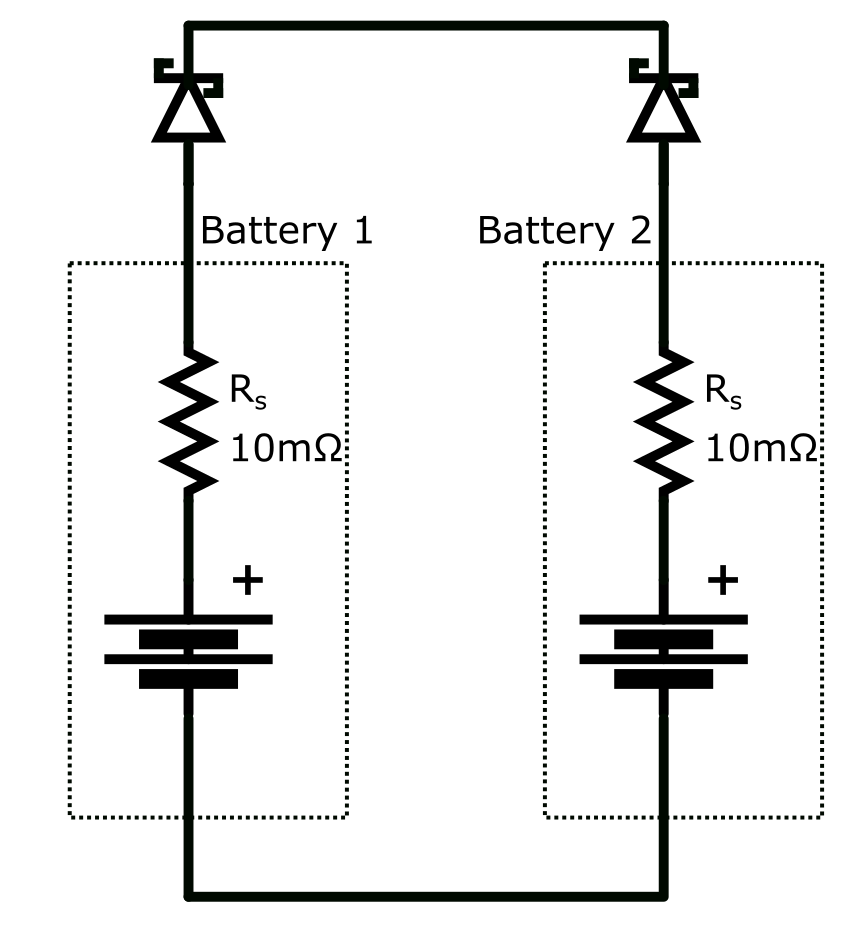Previous tests show that during the initial engagement of a airsoft
rifle, the circuit can see upwards of 47.5amps. Am I correct in
assuming that the Single Pole Double Throw switch would indeed need to
be rated approx. 50amps?
Yes and no. It needs to be rated to have 50A peak. This is a very short pulse while the motor is ramping up - you can get a way with a less beefy switch, especially since it won't be switching the current, and current will only flow when the connection is already made. Once the motor is spooled up, the current is smaller, on the order of a few amperes. A lot of smaller switches should work.
I would like to respectfully disagree with the following:
I'm skeptical about your need for a transfer switch in the first
place. If you are just willing to extend battery life, you can just
parallel the two battery packs directly.
While true when one has full control over the batteries, but even then, I would not advise it. The batteries commonly used in airsoft are often rated to provide on the order of 100A, and often will provide far more when short circuited. Having one battery have an issue, you now have not one but two batteries that potentially destroy themselves - and when these go, they don't go in a gentle poof like phone batteries do. I would like to link to the following video, where Photoinduction demonstrates just how fast this all happens:
Battery short circuited internally by poking the two layers together
I think it might actually be doable to diode-protect the batteries - again, these current spikes are /very/ short.
All that said, I don't really see the point of this setup. For the cost of the switch and extra connectors, you should likely find a bigger battery on hobbyking or similar. If it is a pure mental exercise, let me know, I can give some more information about this.
Edit to extend the depth of the response:
Safetywise, the key is that when you put batteries in parallel, you have to make sure that they are at exactly the same voltage, and have very closely matched internal resistance rating.
Airsoft/RC batteries can have internal resistances less than 10mOhm. That would mean, if I take two of these batteries, and put them in parallel, without any load, we get the following circuit:

Now, let's say that the battery on the left is slightly more charged than the battery on the right - only 0.1V difference. This means the battery that is charged to a slightly higher voltage, will try to charge the second battery to the same level. Since there is a 0.1V difference, the initial current will be 5A! That means that just by connecting the two batteries, 5A of current will flow from one into the other. If your battery can't take being charged at this current (they tend to be far more picky when it comes to charging currents), you could damage the battery.
In order to prevent this, you can insert a diode in series with the battery. If the batteries are now less charged, the diode will prevent the current flowing into that battery. However, diodes have a voltage drop. This could cause issues when you try to start the motor, and will cause loss of energy (as part of the power is wasted in the diode). This is why production systems that put powerful batteries in parallel will usually have a MOSFET as switch for every chain of cells, and will actively monitor each to ensure none of them tries to charge the others.
 The diodes have the additional benefit that they will prevent a short circuit in one battery cause problems in the second - it will block external flow back into the damaged battery, saving your second battery.
The diodes have the additional benefit that they will prevent a short circuit in one battery cause problems in the second - it will block external flow back into the damaged battery, saving your second battery.
The problem can get more complicated when you try to use different batteries (same voltage, but different internal resistance). Now, during load, the battery with the lowest internal resistance will provide most of the current. This will cause it to discharge slightly faster than the second battery. When the load is removed, this second battery will try and charge first battery back up to the same level. This will then repeat over and over again.
The main reason it gets more complicated with these batteries, more complicated than common with smaller batteries, is because they have such low internal resistance. In the case of smaller batteries - be it AA-type rechargeable NiMH batteries, or even 18650 lithium cells - the internal resistance is height enough that it can form a kind of regulator: it will prevent any high currents due to slight mismatches. If my memory serves me right, most 18650 lithium cells offer internal impedance on the order of 100mOhn (in our 0.1V difference example above, this would give a current of "only" 500mA). High end RC/Airosft batteries, that are new, and fully charged, can get as low as 3-4 mOhm.
This is also the reason why you should not underestimate the capabilities of these batteries to do damage. Unlike most batteries, that are optimized to have as much charge in them. This means they have a somewhat high internal resistance, and while a short can be damaging, and cause the cells to get hot, expand, and perhaps rupture their case, batteries for the airsoft and RC world are built to be able to dump their energy as fast as possible - and they can do so at such a rate they will blow themselves up within seconds of a short-circuit condition.
(I realize now that I might have gone a bit off topic here, sorry)





